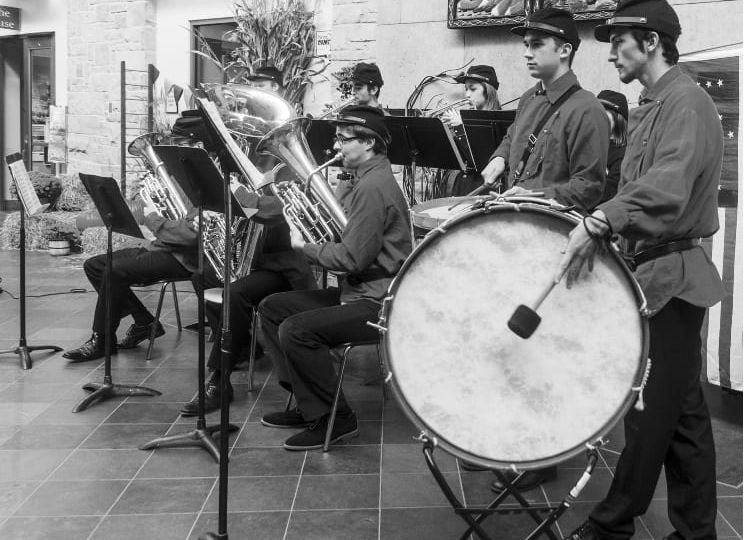
Students and faculty gathered in Crossroads on Tuesday afternoon, where St. Olaf’s own Manitou Regimental Brass Band performed songs from the Civil War era under the direction of Associate Professor of Music Paul Niemisto.
The band, dressed in Northern uniforms and bearing Civil War-era American flags, played well-known pieces like “The Battle Cry of Freedom” and “Dixie,” as well as more obscure numbers such as the 1865 version of “The Star Spangled Banner” and “John Brown’s Body,” a song which later evolved into “The Battle Hymn of the Republic.”
The performance was a prelude to a lecture by Dr. Christian McWhirter titled “Music and the Meaning of the Civil War,” which immediately followed the performance in Viking Theater.
“The Civil War [was] essentially a war fought to music,” said McWhirter to an audience of students and faculty from the music, history and American studies departments. “You’d be hard-pressed to find another war with as many anthems associated with it.” An assistant editor for the Papers of Abraham Lincoln, a project compiling all documents written by or to Lincoln in a single database, McWhirter published his book, “Battle Hymns: The Power and Popularity of Music in the Civil War,” in March of 2012.
2011-2015 marks the 150th anniversary of the American Civil War, commonly cited as the bloodiest war in American history. Over the four-year course of the war, approximately 625,000 soldiers were killed fighting for either the Union or the 11 Confederate States of America. This total comprises almost half the number of U.S. casualties from the Revolutionary War to the present day.
McWhirter looked at the music of the Civil War from a historian’s perspective. He showed how, due to the availability of instruments and the burgeoning U.S. music industry, an astonishing number of songs were written about the war – so many that one publishing company reported that they were receiving “50-70 new submissions a day.”
“Once the war begins, there is an explosion of published and amateur music,” McWhirter said. “By the best estimations we have, something like nine or ten thousand different songs were published during the Civil War.”
But why was music the dominant art form during the war between the states?
“What’s interesting is that music, unlike other literary forms and other ways of expressing yourself culturally, did not require literacy,” said McWhirter. “You could spread music by word of mouth, you could pick it up by hearing other people sing it and that made it more democratizing and more easy to master than other ways of communicating.”
But it wasn’t just its ease of transmission and publishing that made music so ubiquitous during the Civil War; it was also its ability to carry “meaning, emotion and ideological weight.”
“People want ways to understand the war,” McWhirter said, “ways to make sense of the war. And so a place they naturally turn to is music. What I think people were looking for was a way to define for themselves what they were fighting for and why they were doing it and to communicate those ideas to others.”
wilder@stolaf.edu
Photo Credit: ANDREW WILDER/MANITOU MESSENGER

